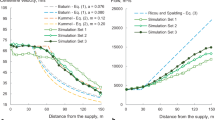Abstract
Acoustic engineers are faced with the challenge of minimising reverberation time in their designs so as to contribute to the health and well-being of those traveling by train and those on the platforms. Although the problem is easy to identify, it is not as simple to solve. The acoustical environment of a train tunnel is complex, with a variety of noise contributing factors such as train announcements, speech of commuters, ventilation systems, electrical equipment and wheel and rail noise. As a result, there is some difficulty in modeling the complete acoustic environment with computational or acoustic first principles. In this study, an experimental rig was constructed to model the acoustic behavior within a tunnel. The modal properties for the 300 Hz to 1500 Hz range, including resonances and mode shapes were identified and were shown to successfully correspond to theoretical results and a computational model created in COMSOL using Finite Element Analysis.
Similar content being viewed by others
References
Kang J. The unsuitability of the classic room acoustical theory in long enclosures. Architectural Science Review, 1996, 39(2): 89–94
Redmore T L. A method to predict the transmission of sound through corridors. Applied Acoustics, 1982, 15(2): 133–146
Fahy F. Sound and structural vibration radiation, transmission and response. London: Academic Press Inc. (London) Ltd., 1985
Raichel D R. The science and applications of acoustics. Second ed. New York, USA: Springer Science + Business Media, Inc., 2006
Kinsler L E. Fundamentals of acoustics. Third ed., New York: Wiley, 1982
Fahy F. Foundations of engineering acoustics. California, USA: Elsevier Academic Press, 2005
Marburg S. Six elements per wavelength: is that enough? Journal of Computational Acoustics, 2002, 10(1): 25–51
Krasilovsky E. Design of a train tunnel rig for measurement of reverberation time, in School of Mechanical and Manufacturing Engineering, University of New South Wales: Sydney, 2011, 104
Hodgson M R, Orlowski R J. Acoustic scale modelling of factories, Part I: principles, instrumentation and techniques. Journal of Sound and Vibration, 1987, 113(1): 29–46
Beranek L L. Acoustics. New York, USA: Acoustical Society of America, 1993
Author information
Authors and Affiliations
Corresponding author
Rights and permissions
About this article
Cite this article
D’Souza, J.B., Kanapathipillai, S. Experimental and computational validation of a scaled train tunnel model using modal analysis. Front. Mech. Eng. 8, 420–428 (2013). https://doi.org/10.1007/s11465-013-0281-7
Received:
Accepted:
Published:
Issue Date:
DOI: https://doi.org/10.1007/s11465-013-0281-7




